Project Proposal: Analyzing Advancements in Renewable Energy Sources
VerifiedAdded on 2023/06/03
|10
|4940
|221
Project
AI Summary
This project proposal delves into the advancements in renewable energy sources, addressing the growing global energy demand and the necessity for sustainable alternatives. It reviews various journal articles to highlight advancements in renewable energy technologies, utilizing both qualitative and quantitative data collection methods to analyze their impact. The proposal outlines research questions, aims, and objectives, including examining the role of renewable energy in reducing reliance on non-renewable sources and identifying problems solved through these advancements. The methodology incorporates a positivism research philosophy and includes a detailed schedule for the research, aiming to demonstrate the feasibility and significance of renewable energy in meeting future energy needs while mitigating environmental concerns.
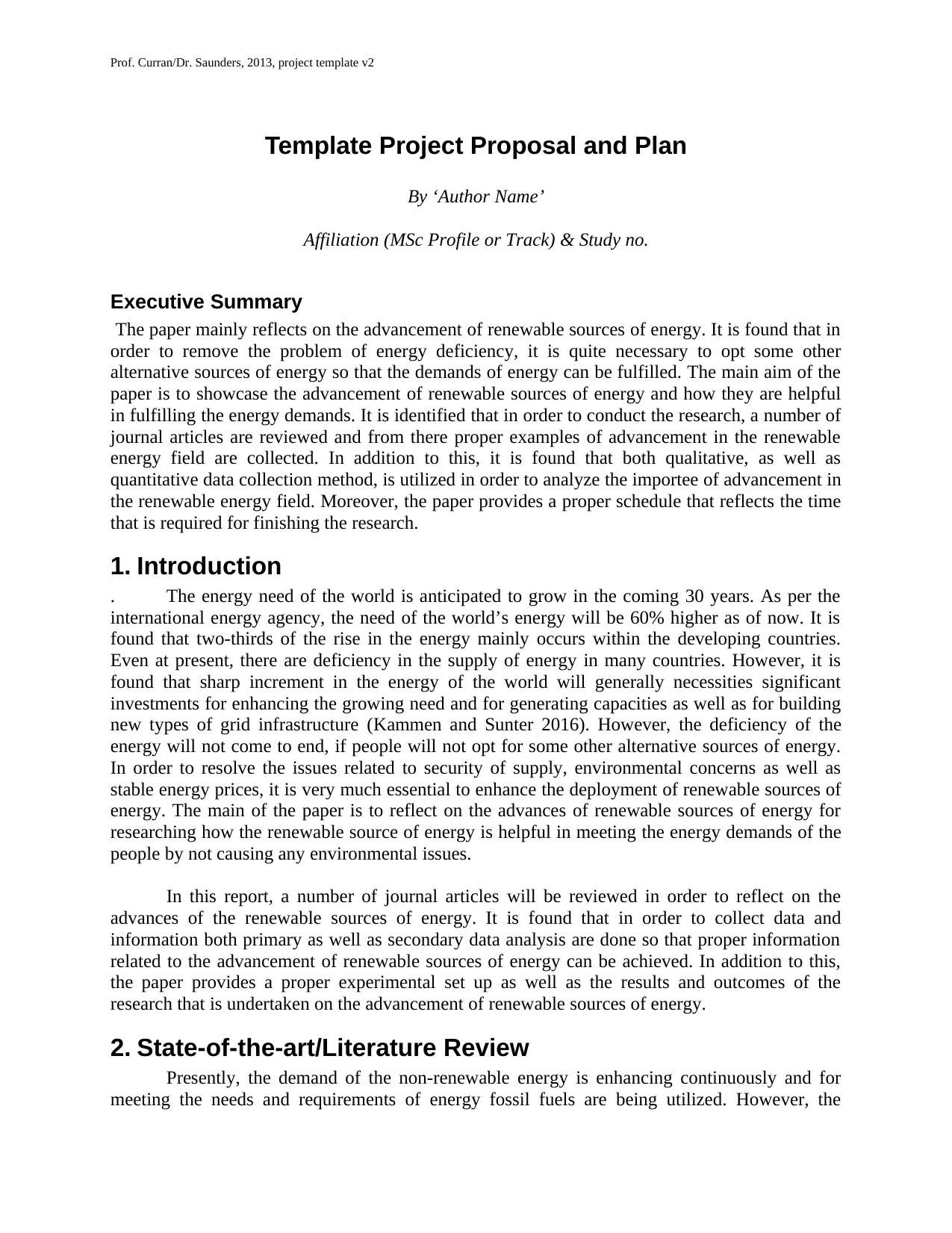
Prof. Curran/Dr. Saunders, 2013, project template v2
Template Project Proposal and Plan
By ‘Author Name’
Affiliation (MSc Profile or Track) & Study no.
Executive Summary
The paper mainly reflects on the advancement of renewable sources of energy. It is found that in
order to remove the problem of energy deficiency, it is quite necessary to opt some other
alternative sources of energy so that the demands of energy can be fulfilled. The main aim of the
paper is to showcase the advancement of renewable sources of energy and how they are helpful
in fulfilling the energy demands. It is identified that in order to conduct the research, a number of
journal articles are reviewed and from there proper examples of advancement in the renewable
energy field are collected. In addition to this, it is found that both qualitative, as well as
quantitative data collection method, is utilized in order to analyze the importee of advancement in
the renewable energy field. Moreover, the paper provides a proper schedule that reflects the time
that is required for finishing the research.
1. Introduction
. The energy need of the world is anticipated to grow in the coming 30 years. As per the
international energy agency, the need of the world’s energy will be 60% higher as of now. It is
found that two-thirds of the rise in the energy mainly occurs within the developing countries.
Even at present, there are deficiency in the supply of energy in many countries. However, it is
found that sharp increment in the energy of the world will generally necessities significant
investments for enhancing the growing need and for generating capacities as well as for building
new types of grid infrastructure (Kammen and Sunter 2016). However, the deficiency of the
energy will not come to end, if people will not opt for some other alternative sources of energy.
In order to resolve the issues related to security of supply, environmental concerns as well as
stable energy prices, it is very much essential to enhance the deployment of renewable sources of
energy. The main of the paper is to reflect on the advances of renewable sources of energy for
researching how the renewable source of energy is helpful in meeting the energy demands of the
people by not causing any environmental issues.
In this report, a number of journal articles will be reviewed in order to reflect on the
advances of the renewable sources of energy. It is found that in order to collect data and
information both primary as well as secondary data analysis are done so that proper information
related to the advancement of renewable sources of energy can be achieved. In addition to this,
the paper provides a proper experimental set up as well as the results and outcomes of the
research that is undertaken on the advancement of renewable sources of energy.
2. State-of-the-art/Literature Review
Presently, the demand of the non-renewable energy is enhancing continuously and for
meeting the needs and requirements of energy fossil fuels are being utilized. However, the
Template Project Proposal and Plan
By ‘Author Name’
Affiliation (MSc Profile or Track) & Study no.
Executive Summary
The paper mainly reflects on the advancement of renewable sources of energy. It is found that in
order to remove the problem of energy deficiency, it is quite necessary to opt some other
alternative sources of energy so that the demands of energy can be fulfilled. The main aim of the
paper is to showcase the advancement of renewable sources of energy and how they are helpful
in fulfilling the energy demands. It is identified that in order to conduct the research, a number of
journal articles are reviewed and from there proper examples of advancement in the renewable
energy field are collected. In addition to this, it is found that both qualitative, as well as
quantitative data collection method, is utilized in order to analyze the importee of advancement in
the renewable energy field. Moreover, the paper provides a proper schedule that reflects the time
that is required for finishing the research.
1. Introduction
. The energy need of the world is anticipated to grow in the coming 30 years. As per the
international energy agency, the need of the world’s energy will be 60% higher as of now. It is
found that two-thirds of the rise in the energy mainly occurs within the developing countries.
Even at present, there are deficiency in the supply of energy in many countries. However, it is
found that sharp increment in the energy of the world will generally necessities significant
investments for enhancing the growing need and for generating capacities as well as for building
new types of grid infrastructure (Kammen and Sunter 2016). However, the deficiency of the
energy will not come to end, if people will not opt for some other alternative sources of energy.
In order to resolve the issues related to security of supply, environmental concerns as well as
stable energy prices, it is very much essential to enhance the deployment of renewable sources of
energy. The main of the paper is to reflect on the advances of renewable sources of energy for
researching how the renewable source of energy is helpful in meeting the energy demands of the
people by not causing any environmental issues.
In this report, a number of journal articles will be reviewed in order to reflect on the
advances of the renewable sources of energy. It is found that in order to collect data and
information both primary as well as secondary data analysis are done so that proper information
related to the advancement of renewable sources of energy can be achieved. In addition to this,
the paper provides a proper experimental set up as well as the results and outcomes of the
research that is undertaken on the advancement of renewable sources of energy.
2. State-of-the-art/Literature Review
Presently, the demand of the non-renewable energy is enhancing continuously and for
meeting the needs and requirements of energy fossil fuels are being utilized. However, the
Paraphrase This Document
Need a fresh take? Get an instant paraphrase of this document with our AI Paraphraser
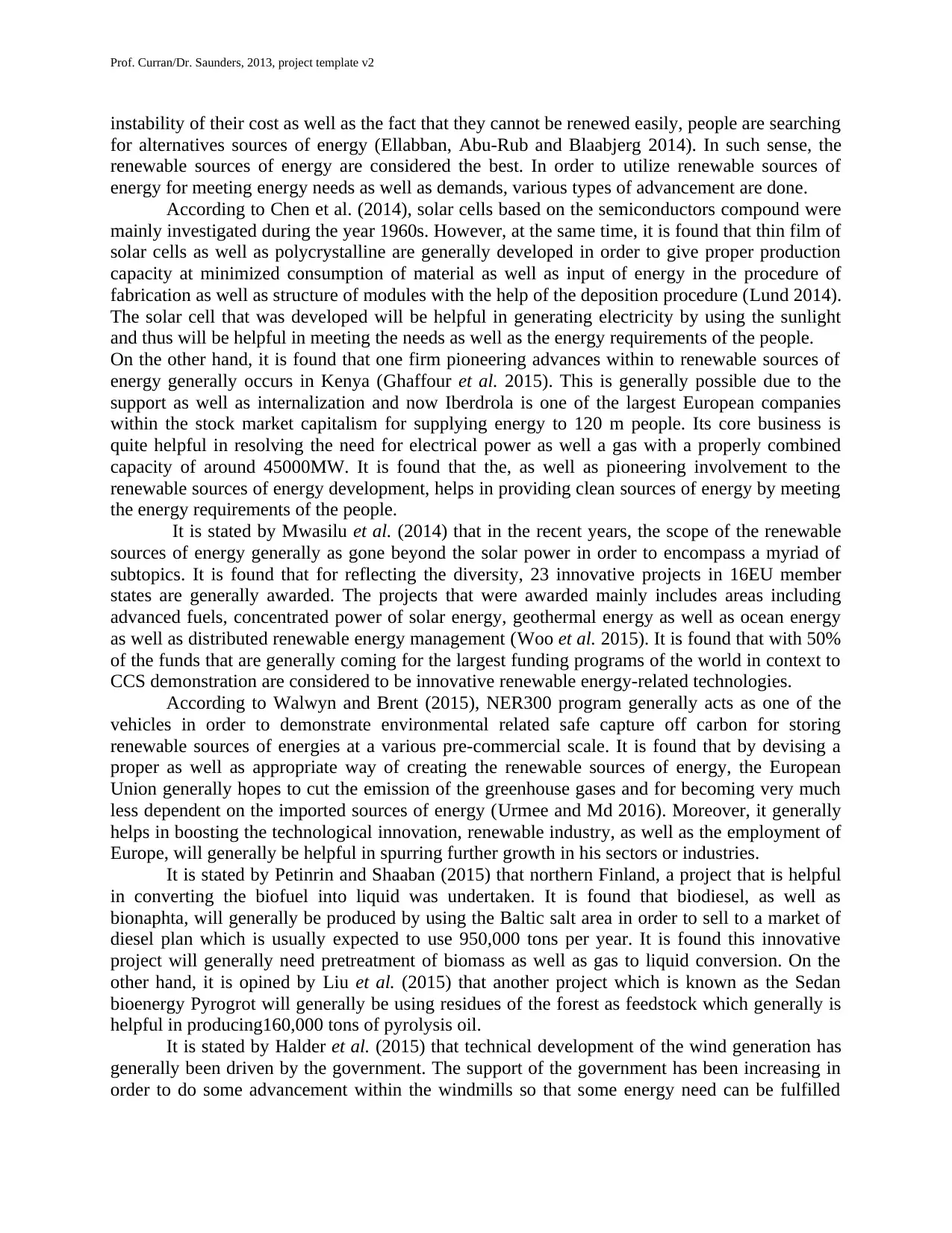
Prof. Curran/Dr. Saunders, 2013, project template v2
instability of their cost as well as the fact that they cannot be renewed easily, people are searching
for alternatives sources of energy (Ellabban, Abu-Rub and Blaabjerg 2014). In such sense, the
renewable sources of energy are considered the best. In order to utilize renewable sources of
energy for meeting energy needs as well as demands, various types of advancement are done.
According to Chen et al. (2014), solar cells based on the semiconductors compound were
mainly investigated during the year 1960s. However, at the same time, it is found that thin film of
solar cells as well as polycrystalline are generally developed in order to give proper production
capacity at minimized consumption of material as well as input of energy in the procedure of
fabrication as well as structure of modules with the help of the deposition procedure (Lund 2014).
The solar cell that was developed will be helpful in generating electricity by using the sunlight
and thus will be helpful in meeting the needs as well as the energy requirements of the people.
On the other hand, it is found that one firm pioneering advances within to renewable sources of
energy generally occurs in Kenya (Ghaffour et al. 2015). This is generally possible due to the
support as well as internalization and now Iberdrola is one of the largest European companies
within the stock market capitalism for supplying energy to 120 m people. Its core business is
quite helpful in resolving the need for electrical power as well a gas with a properly combined
capacity of around 45000MW. It is found that the, as well as pioneering involvement to the
renewable sources of energy development, helps in providing clean sources of energy by meeting
the energy requirements of the people.
It is stated by Mwasilu et al. (2014) that in the recent years, the scope of the renewable
sources of energy generally as gone beyond the solar power in order to encompass a myriad of
subtopics. It is found that for reflecting the diversity, 23 innovative projects in 16EU member
states are generally awarded. The projects that were awarded mainly includes areas including
advanced fuels, concentrated power of solar energy, geothermal energy as well as ocean energy
as well as distributed renewable energy management (Woo et al. 2015). It is found that with 50%
of the funds that are generally coming for the largest funding programs of the world in context to
CCS demonstration are considered to be innovative renewable energy-related technologies.
According to Walwyn and Brent (2015), NER300 program generally acts as one of the
vehicles in order to demonstrate environmental related safe capture off carbon for storing
renewable sources of energies at a various pre-commercial scale. It is found that by devising a
proper as well as appropriate way of creating the renewable sources of energy, the European
Union generally hopes to cut the emission of the greenhouse gases and for becoming very much
less dependent on the imported sources of energy (Urmee and Md 2016). Moreover, it generally
helps in boosting the technological innovation, renewable industry, as well as the employment of
Europe, will generally be helpful in spurring further growth in his sectors or industries.
It is stated by Petinrin and Shaaban (2015) that northern Finland, a project that is helpful
in converting the biofuel into liquid was undertaken. It is found that biodiesel, as well as
bionaphta, will generally be produced by using the Baltic salt area in order to sell to a market of
diesel plan which is usually expected to use 950,000 tons per year. It is found this innovative
project will generally need pretreatment of biomass as well as gas to liquid conversion. On the
other hand, it is opined by Liu et al. (2015) that another project which is known as the Sedan
bioenergy Pyrogrot will generally be using residues of the forest as feedstock which generally is
helpful in producing160,000 tons of pyrolysis oil.
It is stated by Halder et al. (2015) that technical development of the wind generation has
generally been driven by the government. The support of the government has been increasing in
order to do some advancement within the windmills so that some energy need can be fulfilled
instability of their cost as well as the fact that they cannot be renewed easily, people are searching
for alternatives sources of energy (Ellabban, Abu-Rub and Blaabjerg 2014). In such sense, the
renewable sources of energy are considered the best. In order to utilize renewable sources of
energy for meeting energy needs as well as demands, various types of advancement are done.
According to Chen et al. (2014), solar cells based on the semiconductors compound were
mainly investigated during the year 1960s. However, at the same time, it is found that thin film of
solar cells as well as polycrystalline are generally developed in order to give proper production
capacity at minimized consumption of material as well as input of energy in the procedure of
fabrication as well as structure of modules with the help of the deposition procedure (Lund 2014).
The solar cell that was developed will be helpful in generating electricity by using the sunlight
and thus will be helpful in meeting the needs as well as the energy requirements of the people.
On the other hand, it is found that one firm pioneering advances within to renewable sources of
energy generally occurs in Kenya (Ghaffour et al. 2015). This is generally possible due to the
support as well as internalization and now Iberdrola is one of the largest European companies
within the stock market capitalism for supplying energy to 120 m people. Its core business is
quite helpful in resolving the need for electrical power as well a gas with a properly combined
capacity of around 45000MW. It is found that the, as well as pioneering involvement to the
renewable sources of energy development, helps in providing clean sources of energy by meeting
the energy requirements of the people.
It is stated by Mwasilu et al. (2014) that in the recent years, the scope of the renewable
sources of energy generally as gone beyond the solar power in order to encompass a myriad of
subtopics. It is found that for reflecting the diversity, 23 innovative projects in 16EU member
states are generally awarded. The projects that were awarded mainly includes areas including
advanced fuels, concentrated power of solar energy, geothermal energy as well as ocean energy
as well as distributed renewable energy management (Woo et al. 2015). It is found that with 50%
of the funds that are generally coming for the largest funding programs of the world in context to
CCS demonstration are considered to be innovative renewable energy-related technologies.
According to Walwyn and Brent (2015), NER300 program generally acts as one of the
vehicles in order to demonstrate environmental related safe capture off carbon for storing
renewable sources of energies at a various pre-commercial scale. It is found that by devising a
proper as well as appropriate way of creating the renewable sources of energy, the European
Union generally hopes to cut the emission of the greenhouse gases and for becoming very much
less dependent on the imported sources of energy (Urmee and Md 2016). Moreover, it generally
helps in boosting the technological innovation, renewable industry, as well as the employment of
Europe, will generally be helpful in spurring further growth in his sectors or industries.
It is stated by Petinrin and Shaaban (2015) that northern Finland, a project that is helpful
in converting the biofuel into liquid was undertaken. It is found that biodiesel, as well as
bionaphta, will generally be produced by using the Baltic salt area in order to sell to a market of
diesel plan which is usually expected to use 950,000 tons per year. It is found this innovative
project will generally need pretreatment of biomass as well as gas to liquid conversion. On the
other hand, it is opined by Liu et al. (2015) that another project which is known as the Sedan
bioenergy Pyrogrot will generally be using residues of the forest as feedstock which generally is
helpful in producing160,000 tons of pyrolysis oil.
It is stated by Halder et al. (2015) that technical development of the wind generation has
generally been driven by the government. The support of the government has been increasing in
order to do some advancement within the windmills so that some energy need can be fulfilled
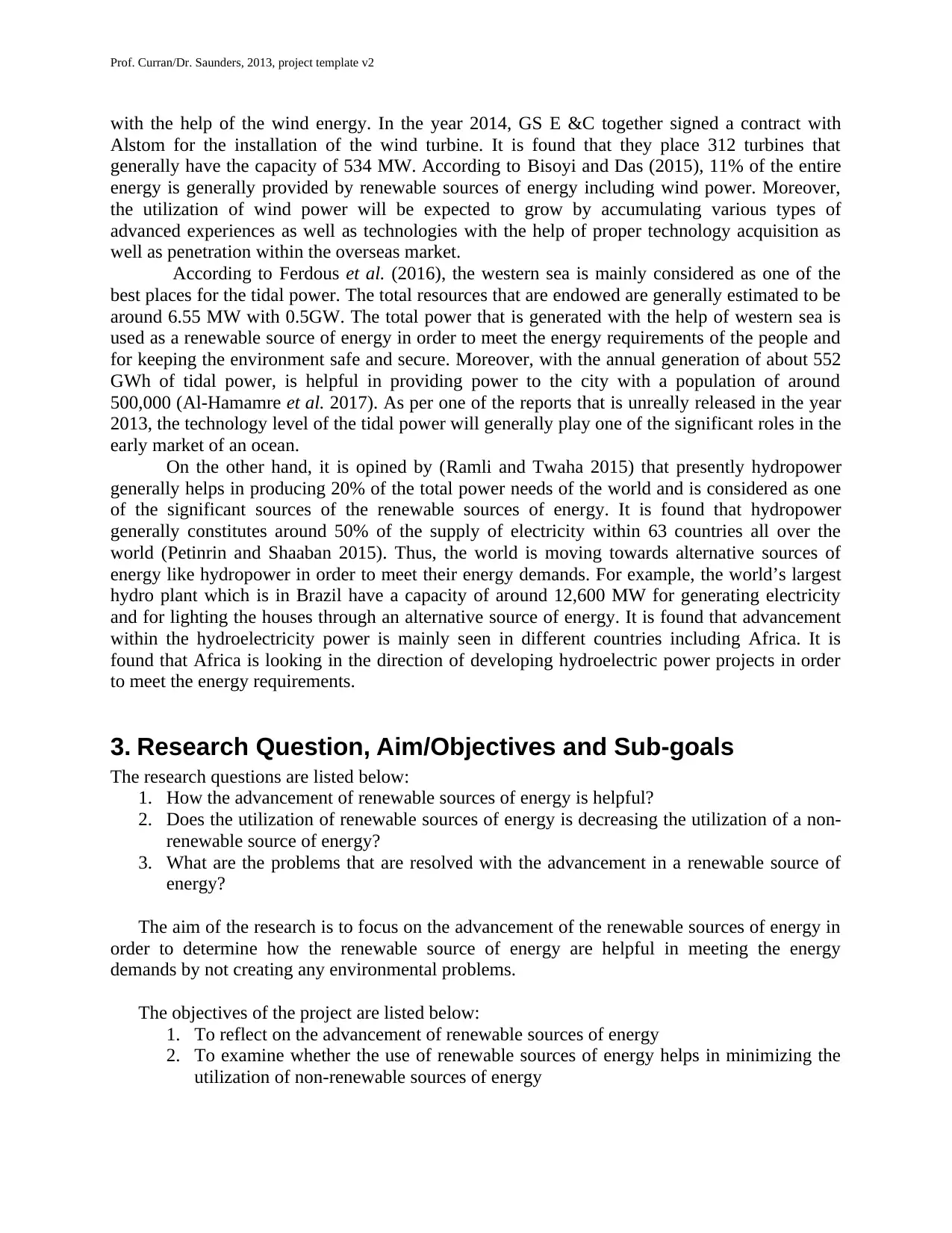
Prof. Curran/Dr. Saunders, 2013, project template v2
with the help of the wind energy. In the year 2014, GS E &C together signed a contract with
Alstom for the installation of the wind turbine. It is found that they place 312 turbines that
generally have the capacity of 534 MW. According to Bisoyi and Das (2015), 11% of the entire
energy is generally provided by renewable sources of energy including wind power. Moreover,
the utilization of wind power will be expected to grow by accumulating various types of
advanced experiences as well as technologies with the help of proper technology acquisition as
well as penetration within the overseas market.
According to Ferdous et al. (2016), the western sea is mainly considered as one of the
best places for the tidal power. The total resources that are endowed are generally estimated to be
around 6.55 MW with 0.5GW. The total power that is generated with the help of western sea is
used as a renewable source of energy in order to meet the energy requirements of the people and
for keeping the environment safe and secure. Moreover, with the annual generation of about 552
GWh of tidal power, is helpful in providing power to the city with a population of around
500,000 (Al-Hamamre et al. 2017). As per one of the reports that is unreally released in the year
2013, the technology level of the tidal power will generally play one of the significant roles in the
early market of an ocean.
On the other hand, it is opined by (Ramli and Twaha 2015) that presently hydropower
generally helps in producing 20% of the total power needs of the world and is considered as one
of the significant sources of the renewable sources of energy. It is found that hydropower
generally constitutes around 50% of the supply of electricity within 63 countries all over the
world (Petinrin and Shaaban 2015). Thus, the world is moving towards alternative sources of
energy like hydropower in order to meet their energy demands. For example, the world’s largest
hydro plant which is in Brazil have a capacity of around 12,600 MW for generating electricity
and for lighting the houses through an alternative source of energy. It is found that advancement
within the hydroelectricity power is mainly seen in different countries including Africa. It is
found that Africa is looking in the direction of developing hydroelectric power projects in order
to meet the energy requirements.
3. Research Question, Aim/Objectives and Sub-goals
The research questions are listed below:
1. How the advancement of renewable sources of energy is helpful?
2. Does the utilization of renewable sources of energy is decreasing the utilization of a non-
renewable source of energy?
3. What are the problems that are resolved with the advancement in a renewable source of
energy?
The aim of the research is to focus on the advancement of the renewable sources of energy in
order to determine how the renewable source of energy are helpful in meeting the energy
demands by not creating any environmental problems.
The objectives of the project are listed below:
1. To reflect on the advancement of renewable sources of energy
2. To examine whether the use of renewable sources of energy helps in minimizing the
utilization of non-renewable sources of energy
with the help of the wind energy. In the year 2014, GS E &C together signed a contract with
Alstom for the installation of the wind turbine. It is found that they place 312 turbines that
generally have the capacity of 534 MW. According to Bisoyi and Das (2015), 11% of the entire
energy is generally provided by renewable sources of energy including wind power. Moreover,
the utilization of wind power will be expected to grow by accumulating various types of
advanced experiences as well as technologies with the help of proper technology acquisition as
well as penetration within the overseas market.
According to Ferdous et al. (2016), the western sea is mainly considered as one of the
best places for the tidal power. The total resources that are endowed are generally estimated to be
around 6.55 MW with 0.5GW. The total power that is generated with the help of western sea is
used as a renewable source of energy in order to meet the energy requirements of the people and
for keeping the environment safe and secure. Moreover, with the annual generation of about 552
GWh of tidal power, is helpful in providing power to the city with a population of around
500,000 (Al-Hamamre et al. 2017). As per one of the reports that is unreally released in the year
2013, the technology level of the tidal power will generally play one of the significant roles in the
early market of an ocean.
On the other hand, it is opined by (Ramli and Twaha 2015) that presently hydropower
generally helps in producing 20% of the total power needs of the world and is considered as one
of the significant sources of the renewable sources of energy. It is found that hydropower
generally constitutes around 50% of the supply of electricity within 63 countries all over the
world (Petinrin and Shaaban 2015). Thus, the world is moving towards alternative sources of
energy like hydropower in order to meet their energy demands. For example, the world’s largest
hydro plant which is in Brazil have a capacity of around 12,600 MW for generating electricity
and for lighting the houses through an alternative source of energy. It is found that advancement
within the hydroelectricity power is mainly seen in different countries including Africa. It is
found that Africa is looking in the direction of developing hydroelectric power projects in order
to meet the energy requirements.
3. Research Question, Aim/Objectives and Sub-goals
The research questions are listed below:
1. How the advancement of renewable sources of energy is helpful?
2. Does the utilization of renewable sources of energy is decreasing the utilization of a non-
renewable source of energy?
3. What are the problems that are resolved with the advancement in a renewable source of
energy?
The aim of the research is to focus on the advancement of the renewable sources of energy in
order to determine how the renewable source of energy are helpful in meeting the energy
demands by not creating any environmental problems.
The objectives of the project are listed below:
1. To reflect on the advancement of renewable sources of energy
2. To examine whether the use of renewable sources of energy helps in minimizing the
utilization of non-renewable sources of energy
⊘ This is a preview!⊘
Do you want full access?
Subscribe today to unlock all pages.

Trusted by 1+ million students worldwide
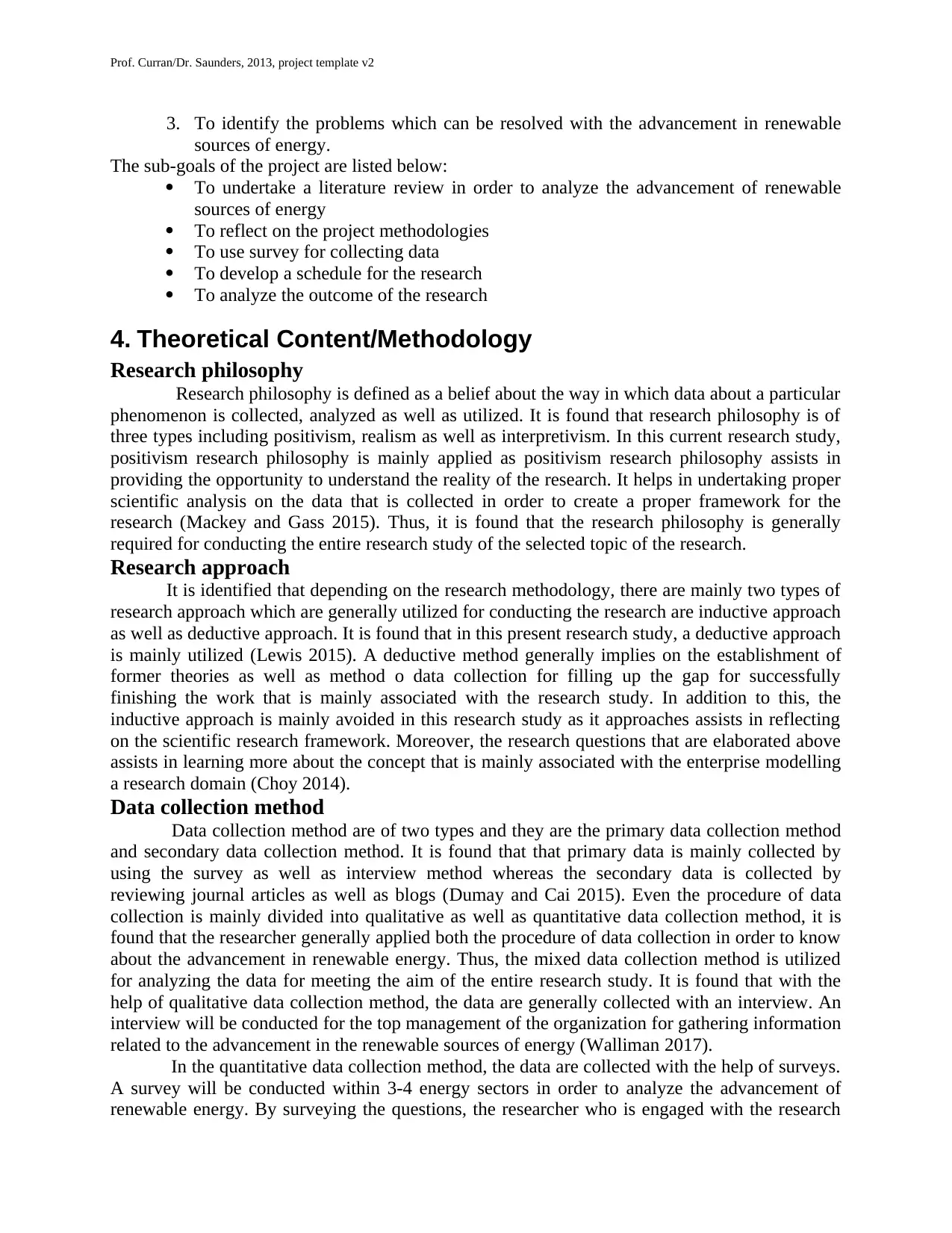
Prof. Curran/Dr. Saunders, 2013, project template v2
3. To identify the problems which can be resolved with the advancement in renewable
sources of energy.
The sub-goals of the project are listed below:
To undertake a literature review in order to analyze the advancement of renewable
sources of energy
To reflect on the project methodologies
To use survey for collecting data
To develop a schedule for the research
To analyze the outcome of the research
4. Theoretical Content/Methodology
Research philosophy
Research philosophy is defined as a belief about the way in which data about a particular
phenomenon is collected, analyzed as well as utilized. It is found that research philosophy is of
three types including positivism, realism as well as interpretivism. In this current research study,
positivism research philosophy is mainly applied as positivism research philosophy assists in
providing the opportunity to understand the reality of the research. It helps in undertaking proper
scientific analysis on the data that is collected in order to create a proper framework for the
research (Mackey and Gass 2015). Thus, it is found that the research philosophy is generally
required for conducting the entire research study of the selected topic of the research.
Research approach
It is identified that depending on the research methodology, there are mainly two types of
research approach which are generally utilized for conducting the research are inductive approach
as well as deductive approach. It is found that in this present research study, a deductive approach
is mainly utilized (Lewis 2015). A deductive method generally implies on the establishment of
former theories as well as method o data collection for filling up the gap for successfully
finishing the work that is mainly associated with the research study. In addition to this, the
inductive approach is mainly avoided in this research study as it approaches assists in reflecting
on the scientific research framework. Moreover, the research questions that are elaborated above
assists in learning more about the concept that is mainly associated with the enterprise modelling
a research domain (Choy 2014).
Data collection method
Data collection method are of two types and they are the primary data collection method
and secondary data collection method. It is found that that primary data is mainly collected by
using the survey as well as interview method whereas the secondary data is collected by
reviewing journal articles as well as blogs (Dumay and Cai 2015). Even the procedure of data
collection is mainly divided into qualitative as well as quantitative data collection method, it is
found that the researcher generally applied both the procedure of data collection in order to know
about the advancement in renewable energy. Thus, the mixed data collection method is utilized
for analyzing the data for meeting the aim of the entire research study. It is found that with the
help of qualitative data collection method, the data are generally collected with an interview. An
interview will be conducted for the top management of the organization for gathering information
related to the advancement in the renewable sources of energy (Walliman 2017).
In the quantitative data collection method, the data are collected with the help of surveys.
A survey will be conducted within 3-4 energy sectors in order to analyze the advancement of
renewable energy. By surveying the questions, the researcher who is engaged with the research
3. To identify the problems which can be resolved with the advancement in renewable
sources of energy.
The sub-goals of the project are listed below:
To undertake a literature review in order to analyze the advancement of renewable
sources of energy
To reflect on the project methodologies
To use survey for collecting data
To develop a schedule for the research
To analyze the outcome of the research
4. Theoretical Content/Methodology
Research philosophy
Research philosophy is defined as a belief about the way in which data about a particular
phenomenon is collected, analyzed as well as utilized. It is found that research philosophy is of
three types including positivism, realism as well as interpretivism. In this current research study,
positivism research philosophy is mainly applied as positivism research philosophy assists in
providing the opportunity to understand the reality of the research. It helps in undertaking proper
scientific analysis on the data that is collected in order to create a proper framework for the
research (Mackey and Gass 2015). Thus, it is found that the research philosophy is generally
required for conducting the entire research study of the selected topic of the research.
Research approach
It is identified that depending on the research methodology, there are mainly two types of
research approach which are generally utilized for conducting the research are inductive approach
as well as deductive approach. It is found that in this present research study, a deductive approach
is mainly utilized (Lewis 2015). A deductive method generally implies on the establishment of
former theories as well as method o data collection for filling up the gap for successfully
finishing the work that is mainly associated with the research study. In addition to this, the
inductive approach is mainly avoided in this research study as it approaches assists in reflecting
on the scientific research framework. Moreover, the research questions that are elaborated above
assists in learning more about the concept that is mainly associated with the enterprise modelling
a research domain (Choy 2014).
Data collection method
Data collection method are of two types and they are the primary data collection method
and secondary data collection method. It is found that that primary data is mainly collected by
using the survey as well as interview method whereas the secondary data is collected by
reviewing journal articles as well as blogs (Dumay and Cai 2015). Even the procedure of data
collection is mainly divided into qualitative as well as quantitative data collection method, it is
found that the researcher generally applied both the procedure of data collection in order to know
about the advancement in renewable energy. Thus, the mixed data collection method is utilized
for analyzing the data for meeting the aim of the entire research study. It is found that with the
help of qualitative data collection method, the data are generally collected with an interview. An
interview will be conducted for the top management of the organization for gathering information
related to the advancement in the renewable sources of energy (Walliman 2017).
In the quantitative data collection method, the data are collected with the help of surveys.
A survey will be conducted within 3-4 energy sectors in order to analyze the advancement of
renewable energy. By surveying the questions, the researcher who is engaged with the research
Paraphrase This Document
Need a fresh take? Get an instant paraphrase of this document with our AI Paraphraser
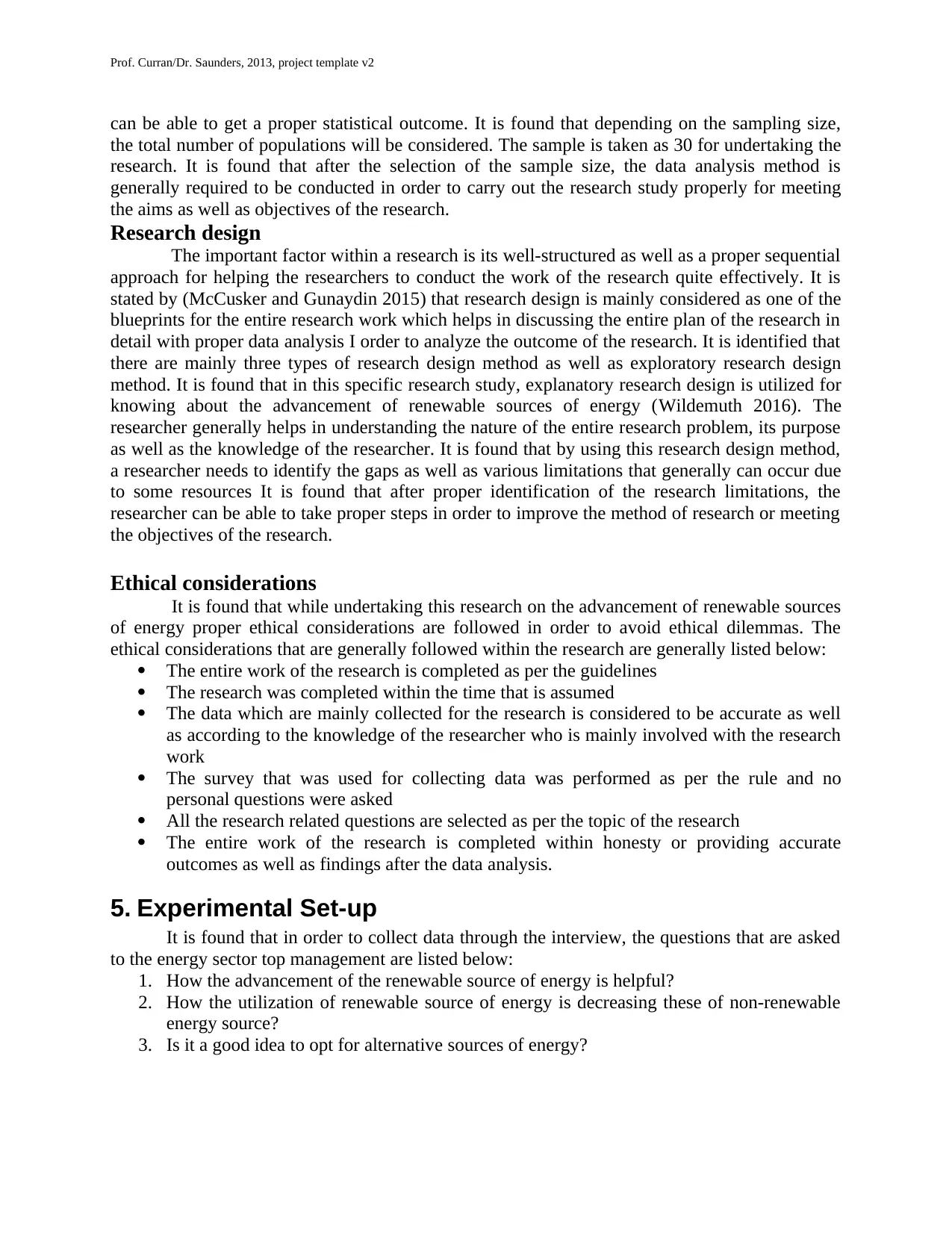
Prof. Curran/Dr. Saunders, 2013, project template v2
can be able to get a proper statistical outcome. It is found that depending on the sampling size,
the total number of populations will be considered. The sample is taken as 30 for undertaking the
research. It is found that after the selection of the sample size, the data analysis method is
generally required to be conducted in order to carry out the research study properly for meeting
the aims as well as objectives of the research.
Research design
The important factor within a research is its well-structured as well as a proper sequential
approach for helping the researchers to conduct the work of the research quite effectively. It is
stated by (McCusker and Gunaydin 2015) that research design is mainly considered as one of the
blueprints for the entire research work which helps in discussing the entire plan of the research in
detail with proper data analysis I order to analyze the outcome of the research. It is identified that
there are mainly three types of research design method as well as exploratory research design
method. It is found that in this specific research study, explanatory research design is utilized for
knowing about the advancement of renewable sources of energy (Wildemuth 2016). The
researcher generally helps in understanding the nature of the entire research problem, its purpose
as well as the knowledge of the researcher. It is found that by using this research design method,
a researcher needs to identify the gaps as well as various limitations that generally can occur due
to some resources It is found that after proper identification of the research limitations, the
researcher can be able to take proper steps in order to improve the method of research or meeting
the objectives of the research.
Ethical considerations
It is found that while undertaking this research on the advancement of renewable sources
of energy proper ethical considerations are followed in order to avoid ethical dilemmas. The
ethical considerations that are generally followed within the research are generally listed below:
The entire work of the research is completed as per the guidelines
The research was completed within the time that is assumed
The data which are mainly collected for the research is considered to be accurate as well
as according to the knowledge of the researcher who is mainly involved with the research
work
The survey that was used for collecting data was performed as per the rule and no
personal questions were asked
All the research related questions are selected as per the topic of the research
The entire work of the research is completed within honesty or providing accurate
outcomes as well as findings after the data analysis.
5. Experimental Set-up
It is found that in order to collect data through the interview, the questions that are asked
to the energy sector top management are listed below:
1. How the advancement of the renewable source of energy is helpful?
2. How the utilization of renewable source of energy is decreasing these of non-renewable
energy source?
3. Is it a good idea to opt for alternative sources of energy?
can be able to get a proper statistical outcome. It is found that depending on the sampling size,
the total number of populations will be considered. The sample is taken as 30 for undertaking the
research. It is found that after the selection of the sample size, the data analysis method is
generally required to be conducted in order to carry out the research study properly for meeting
the aims as well as objectives of the research.
Research design
The important factor within a research is its well-structured as well as a proper sequential
approach for helping the researchers to conduct the work of the research quite effectively. It is
stated by (McCusker and Gunaydin 2015) that research design is mainly considered as one of the
blueprints for the entire research work which helps in discussing the entire plan of the research in
detail with proper data analysis I order to analyze the outcome of the research. It is identified that
there are mainly three types of research design method as well as exploratory research design
method. It is found that in this specific research study, explanatory research design is utilized for
knowing about the advancement of renewable sources of energy (Wildemuth 2016). The
researcher generally helps in understanding the nature of the entire research problem, its purpose
as well as the knowledge of the researcher. It is found that by using this research design method,
a researcher needs to identify the gaps as well as various limitations that generally can occur due
to some resources It is found that after proper identification of the research limitations, the
researcher can be able to take proper steps in order to improve the method of research or meeting
the objectives of the research.
Ethical considerations
It is found that while undertaking this research on the advancement of renewable sources
of energy proper ethical considerations are followed in order to avoid ethical dilemmas. The
ethical considerations that are generally followed within the research are generally listed below:
The entire work of the research is completed as per the guidelines
The research was completed within the time that is assumed
The data which are mainly collected for the research is considered to be accurate as well
as according to the knowledge of the researcher who is mainly involved with the research
work
The survey that was used for collecting data was performed as per the rule and no
personal questions were asked
All the research related questions are selected as per the topic of the research
The entire work of the research is completed within honesty or providing accurate
outcomes as well as findings after the data analysis.
5. Experimental Set-up
It is found that in order to collect data through the interview, the questions that are asked
to the energy sector top management are listed below:
1. How the advancement of the renewable source of energy is helpful?
2. How the utilization of renewable source of energy is decreasing these of non-renewable
energy source?
3. Is it a good idea to opt for alternative sources of energy?
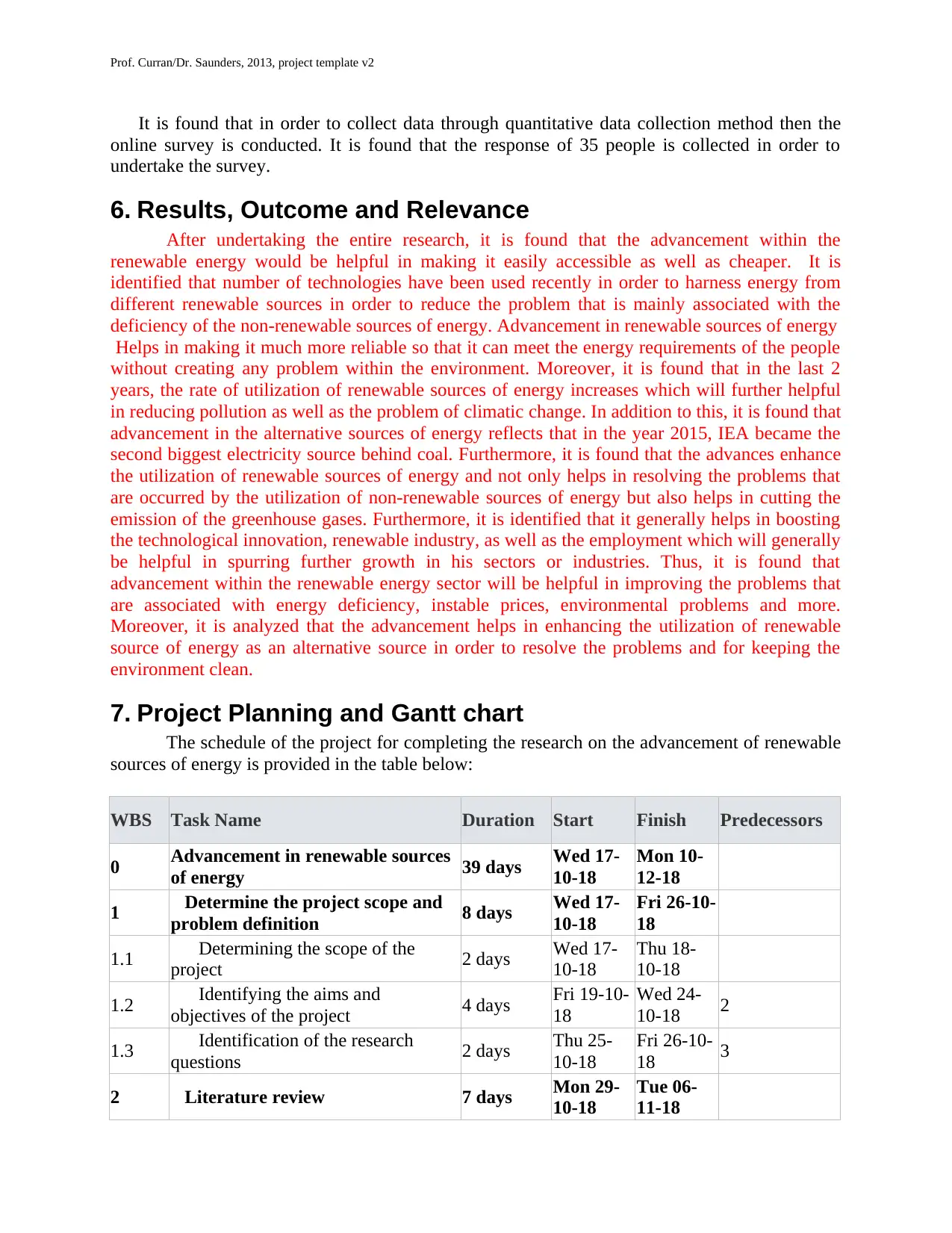
Prof. Curran/Dr. Saunders, 2013, project template v2
It is found that in order to collect data through quantitative data collection method then the
online survey is conducted. It is found that the response of 35 people is collected in order to
undertake the survey.
6. Results, Outcome and Relevance
After undertaking the entire research, it is found that the advancement within the
renewable energy would be helpful in making it easily accessible as well as cheaper. It is
identified that number of technologies have been used recently in order to harness energy from
different renewable sources in order to reduce the problem that is mainly associated with the
deficiency of the non-renewable sources of energy. Advancement in renewable sources of energy
Helps in making it much more reliable so that it can meet the energy requirements of the people
without creating any problem within the environment. Moreover, it is found that in the last 2
years, the rate of utilization of renewable sources of energy increases which will further helpful
in reducing pollution as well as the problem of climatic change. In addition to this, it is found that
advancement in the alternative sources of energy reflects that in the year 2015, IEA became the
second biggest electricity source behind coal. Furthermore, it is found that the advances enhance
the utilization of renewable sources of energy and not only helps in resolving the problems that
are occurred by the utilization of non-renewable sources of energy but also helps in cutting the
emission of the greenhouse gases. Furthermore, it is identified that it generally helps in boosting
the technological innovation, renewable industry, as well as the employment which will generally
be helpful in spurring further growth in his sectors or industries. Thus, it is found that
advancement within the renewable energy sector will be helpful in improving the problems that
are associated with energy deficiency, instable prices, environmental problems and more.
Moreover, it is analyzed that the advancement helps in enhancing the utilization of renewable
source of energy as an alternative source in order to resolve the problems and for keeping the
environment clean.
7. Project Planning and Gantt chart
The schedule of the project for completing the research on the advancement of renewable
sources of energy is provided in the table below:
WBS Task Name Duration Start Finish Predecessors
0 Advancement in renewable sources
of energy 39 days Wed 17-
10-18
Mon 10-
12-18
1 Determine the project scope and
problem definition 8 days Wed 17-
10-18
Fri 26-10-
18
1.1 Determining the scope of the
project 2 days Wed 17-
10-18
Thu 18-
10-18
1.2 Identifying the aims and
objectives of the project 4 days Fri 19-10-
18
Wed 24-
10-18 2
1.3 Identification of the research
questions 2 days Thu 25-
10-18
Fri 26-10-
18 3
2 Literature review 7 days Mon 29-
10-18
Tue 06-
11-18
It is found that in order to collect data through quantitative data collection method then the
online survey is conducted. It is found that the response of 35 people is collected in order to
undertake the survey.
6. Results, Outcome and Relevance
After undertaking the entire research, it is found that the advancement within the
renewable energy would be helpful in making it easily accessible as well as cheaper. It is
identified that number of technologies have been used recently in order to harness energy from
different renewable sources in order to reduce the problem that is mainly associated with the
deficiency of the non-renewable sources of energy. Advancement in renewable sources of energy
Helps in making it much more reliable so that it can meet the energy requirements of the people
without creating any problem within the environment. Moreover, it is found that in the last 2
years, the rate of utilization of renewable sources of energy increases which will further helpful
in reducing pollution as well as the problem of climatic change. In addition to this, it is found that
advancement in the alternative sources of energy reflects that in the year 2015, IEA became the
second biggest electricity source behind coal. Furthermore, it is found that the advances enhance
the utilization of renewable sources of energy and not only helps in resolving the problems that
are occurred by the utilization of non-renewable sources of energy but also helps in cutting the
emission of the greenhouse gases. Furthermore, it is identified that it generally helps in boosting
the technological innovation, renewable industry, as well as the employment which will generally
be helpful in spurring further growth in his sectors or industries. Thus, it is found that
advancement within the renewable energy sector will be helpful in improving the problems that
are associated with energy deficiency, instable prices, environmental problems and more.
Moreover, it is analyzed that the advancement helps in enhancing the utilization of renewable
source of energy as an alternative source in order to resolve the problems and for keeping the
environment clean.
7. Project Planning and Gantt chart
The schedule of the project for completing the research on the advancement of renewable
sources of energy is provided in the table below:
WBS Task Name Duration Start Finish Predecessors
0 Advancement in renewable sources
of energy 39 days Wed 17-
10-18
Mon 10-
12-18
1 Determine the project scope and
problem definition 8 days Wed 17-
10-18
Fri 26-10-
18
1.1 Determining the scope of the
project 2 days Wed 17-
10-18
Thu 18-
10-18
1.2 Identifying the aims and
objectives of the project 4 days Fri 19-10-
18
Wed 24-
10-18 2
1.3 Identification of the research
questions 2 days Thu 25-
10-18
Fri 26-10-
18 3
2 Literature review 7 days Mon 29-
10-18
Tue 06-
11-18
⊘ This is a preview!⊘
Do you want full access?
Subscribe today to unlock all pages.

Trusted by 1+ million students worldwide
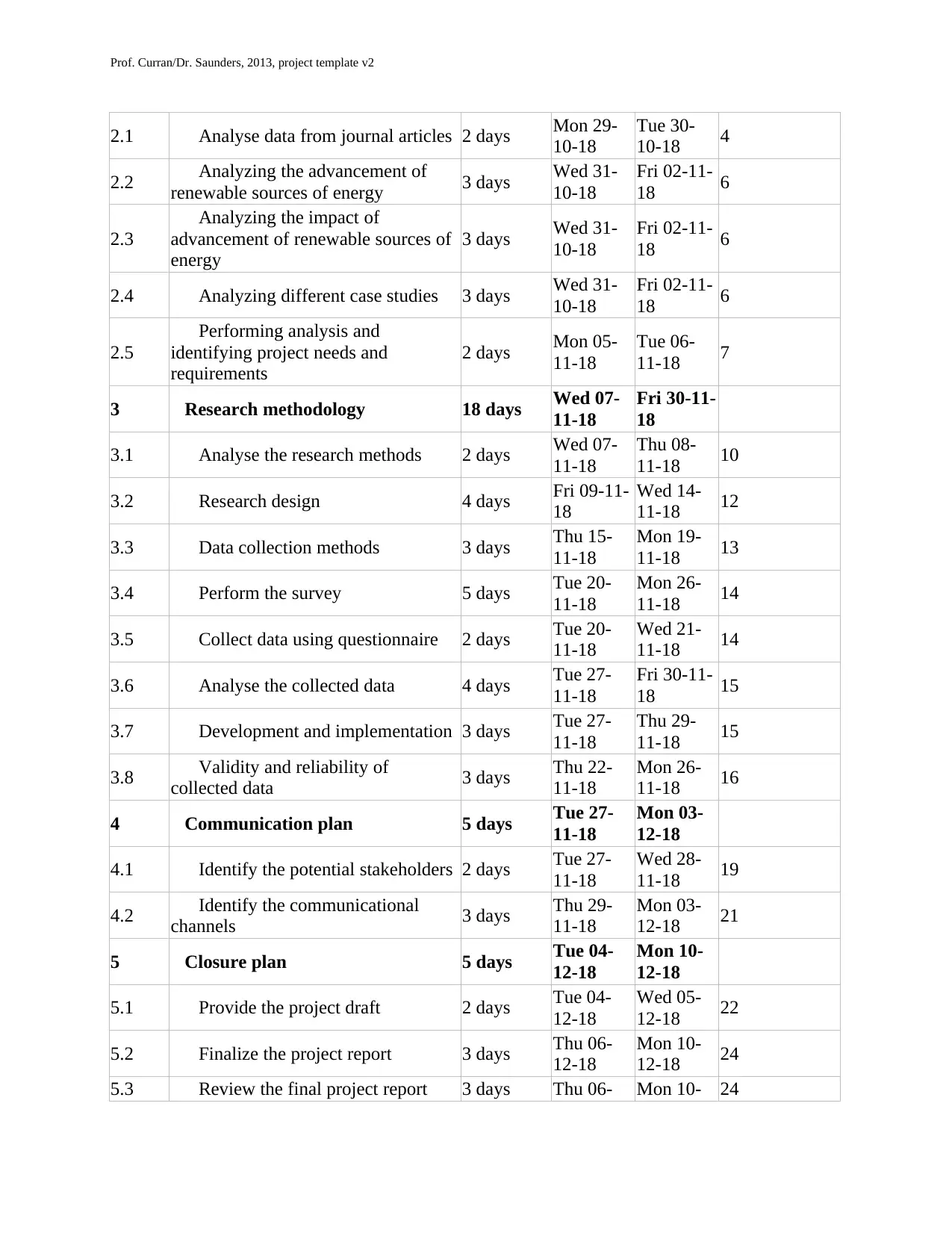
Prof. Curran/Dr. Saunders, 2013, project template v2
2.1 Analyse data from journal articles 2 days Mon 29-
10-18
Tue 30-
10-18 4
2.2 Analyzing the advancement of
renewable sources of energy 3 days Wed 31-
10-18
Fri 02-11-
18 6
2.3
Analyzing the impact of
advancement of renewable sources of
energy
3 days Wed 31-
10-18
Fri 02-11-
18 6
2.4 Analyzing different case studies 3 days Wed 31-
10-18
Fri 02-11-
18 6
2.5
Performing analysis and
identifying project needs and
requirements
2 days Mon 05-
11-18
Tue 06-
11-18 7
3 Research methodology 18 days Wed 07-
11-18
Fri 30-11-
18
3.1 Analyse the research methods 2 days Wed 07-
11-18
Thu 08-
11-18 10
3.2 Research design 4 days Fri 09-11-
18
Wed 14-
11-18 12
3.3 Data collection methods 3 days Thu 15-
11-18
Mon 19-
11-18 13
3.4 Perform the survey 5 days Tue 20-
11-18
Mon 26-
11-18 14
3.5 Collect data using questionnaire 2 days Tue 20-
11-18
Wed 21-
11-18 14
3.6 Analyse the collected data 4 days Tue 27-
11-18
Fri 30-11-
18 15
3.7 Development and implementation 3 days Tue 27-
11-18
Thu 29-
11-18 15
3.8 Validity and reliability of
collected data 3 days Thu 22-
11-18
Mon 26-
11-18 16
4 Communication plan 5 days Tue 27-
11-18
Mon 03-
12-18
4.1 Identify the potential stakeholders 2 days Tue 27-
11-18
Wed 28-
11-18 19
4.2 Identify the communicational
channels 3 days Thu 29-
11-18
Mon 03-
12-18 21
5 Closure plan 5 days Tue 04-
12-18
Mon 10-
12-18
5.1 Provide the project draft 2 days Tue 04-
12-18
Wed 05-
12-18 22
5.2 Finalize the project report 3 days Thu 06-
12-18
Mon 10-
12-18 24
5.3 Review the final project report 3 days Thu 06- Mon 10- 24
2.1 Analyse data from journal articles 2 days Mon 29-
10-18
Tue 30-
10-18 4
2.2 Analyzing the advancement of
renewable sources of energy 3 days Wed 31-
10-18
Fri 02-11-
18 6
2.3
Analyzing the impact of
advancement of renewable sources of
energy
3 days Wed 31-
10-18
Fri 02-11-
18 6
2.4 Analyzing different case studies 3 days Wed 31-
10-18
Fri 02-11-
18 6
2.5
Performing analysis and
identifying project needs and
requirements
2 days Mon 05-
11-18
Tue 06-
11-18 7
3 Research methodology 18 days Wed 07-
11-18
Fri 30-11-
18
3.1 Analyse the research methods 2 days Wed 07-
11-18
Thu 08-
11-18 10
3.2 Research design 4 days Fri 09-11-
18
Wed 14-
11-18 12
3.3 Data collection methods 3 days Thu 15-
11-18
Mon 19-
11-18 13
3.4 Perform the survey 5 days Tue 20-
11-18
Mon 26-
11-18 14
3.5 Collect data using questionnaire 2 days Tue 20-
11-18
Wed 21-
11-18 14
3.6 Analyse the collected data 4 days Tue 27-
11-18
Fri 30-11-
18 15
3.7 Development and implementation 3 days Tue 27-
11-18
Thu 29-
11-18 15
3.8 Validity and reliability of
collected data 3 days Thu 22-
11-18
Mon 26-
11-18 16
4 Communication plan 5 days Tue 27-
11-18
Mon 03-
12-18
4.1 Identify the potential stakeholders 2 days Tue 27-
11-18
Wed 28-
11-18 19
4.2 Identify the communicational
channels 3 days Thu 29-
11-18
Mon 03-
12-18 21
5 Closure plan 5 days Tue 04-
12-18
Mon 10-
12-18
5.1 Provide the project draft 2 days Tue 04-
12-18
Wed 05-
12-18 22
5.2 Finalize the project report 3 days Thu 06-
12-18
Mon 10-
12-18 24
5.3 Review the final project report 3 days Thu 06- Mon 10- 24
Paraphrase This Document
Need a fresh take? Get an instant paraphrase of this document with our AI Paraphraser
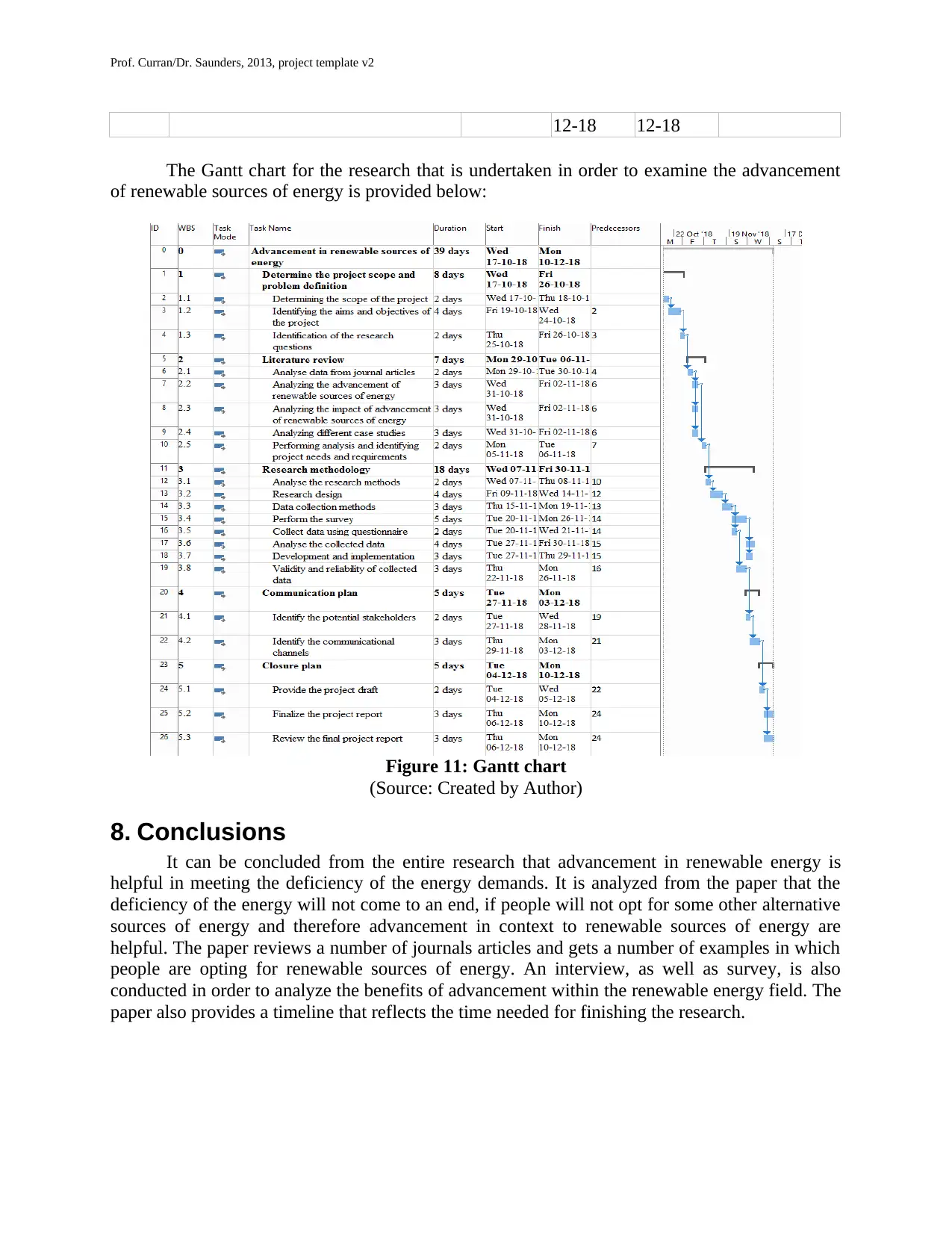
Prof. Curran/Dr. Saunders, 2013, project template v2
12-18 12-18
The Gantt chart for the research that is undertaken in order to examine the advancement
of renewable sources of energy is provided below:
Figure 11: Gantt chart
(Source: Created by Author)
8. Conclusions
It can be concluded from the entire research that advancement in renewable energy is
helpful in meeting the deficiency of the energy demands. It is analyzed from the paper that the
deficiency of the energy will not come to an end, if people will not opt for some other alternative
sources of energy and therefore advancement in context to renewable sources of energy are
helpful. The paper reviews a number of journals articles and gets a number of examples in which
people are opting for renewable sources of energy. An interview, as well as survey, is also
conducted in order to analyze the benefits of advancement within the renewable energy field. The
paper also provides a timeline that reflects the time needed for finishing the research.
12-18 12-18
The Gantt chart for the research that is undertaken in order to examine the advancement
of renewable sources of energy is provided below:
Figure 11: Gantt chart
(Source: Created by Author)
8. Conclusions
It can be concluded from the entire research that advancement in renewable energy is
helpful in meeting the deficiency of the energy demands. It is analyzed from the paper that the
deficiency of the energy will not come to an end, if people will not opt for some other alternative
sources of energy and therefore advancement in context to renewable sources of energy are
helpful. The paper reviews a number of journals articles and gets a number of examples in which
people are opting for renewable sources of energy. An interview, as well as survey, is also
conducted in order to analyze the benefits of advancement within the renewable energy field. The
paper also provides a timeline that reflects the time needed for finishing the research.
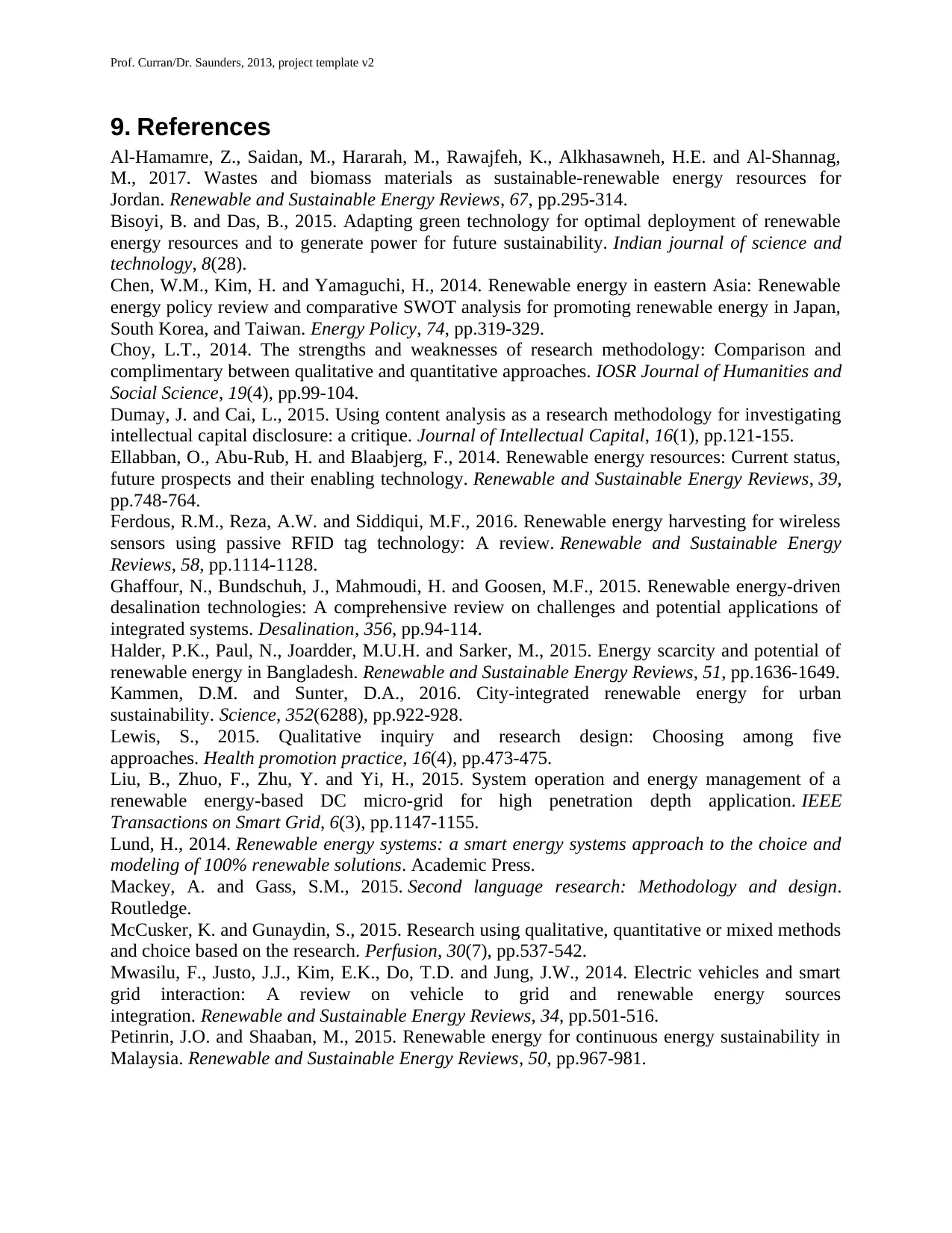
Prof. Curran/Dr. Saunders, 2013, project template v2
9. References
Al-Hamamre, Z., Saidan, M., Hararah, M., Rawajfeh, K., Alkhasawneh, H.E. and Al-Shannag,
M., 2017. Wastes and biomass materials as sustainable-renewable energy resources for
Jordan. Renewable and Sustainable Energy Reviews, 67, pp.295-314.
Bisoyi, B. and Das, B., 2015. Adapting green technology for optimal deployment of renewable
energy resources and to generate power for future sustainability. Indian journal of science and
technology, 8(28).
Chen, W.M., Kim, H. and Yamaguchi, H., 2014. Renewable energy in eastern Asia: Renewable
energy policy review and comparative SWOT analysis for promoting renewable energy in Japan,
South Korea, and Taiwan. Energy Policy, 74, pp.319-329.
Choy, L.T., 2014. The strengths and weaknesses of research methodology: Comparison and
complimentary between qualitative and quantitative approaches. IOSR Journal of Humanities and
Social Science, 19(4), pp.99-104.
Dumay, J. and Cai, L., 2015. Using content analysis as a research methodology for investigating
intellectual capital disclosure: a critique. Journal of Intellectual Capital, 16(1), pp.121-155.
Ellabban, O., Abu-Rub, H. and Blaabjerg, F., 2014. Renewable energy resources: Current status,
future prospects and their enabling technology. Renewable and Sustainable Energy Reviews, 39,
pp.748-764.
Ferdous, R.M., Reza, A.W. and Siddiqui, M.F., 2016. Renewable energy harvesting for wireless
sensors using passive RFID tag technology: A review. Renewable and Sustainable Energy
Reviews, 58, pp.1114-1128.
Ghaffour, N., Bundschuh, J., Mahmoudi, H. and Goosen, M.F., 2015. Renewable energy-driven
desalination technologies: A comprehensive review on challenges and potential applications of
integrated systems. Desalination, 356, pp.94-114.
Halder, P.K., Paul, N., Joardder, M.U.H. and Sarker, M., 2015. Energy scarcity and potential of
renewable energy in Bangladesh. Renewable and Sustainable Energy Reviews, 51, pp.1636-1649.
Kammen, D.M. and Sunter, D.A., 2016. City-integrated renewable energy for urban
sustainability. Science, 352(6288), pp.922-928.
Lewis, S., 2015. Qualitative inquiry and research design: Choosing among five
approaches. Health promotion practice, 16(4), pp.473-475.
Liu, B., Zhuo, F., Zhu, Y. and Yi, H., 2015. System operation and energy management of a
renewable energy-based DC micro-grid for high penetration depth application. IEEE
Transactions on Smart Grid, 6(3), pp.1147-1155.
Lund, H., 2014. Renewable energy systems: a smart energy systems approach to the choice and
modeling of 100% renewable solutions. Academic Press.
Mackey, A. and Gass, S.M., 2015. Second language research: Methodology and design.
Routledge.
McCusker, K. and Gunaydin, S., 2015. Research using qualitative, quantitative or mixed methods
and choice based on the research. Perfusion, 30(7), pp.537-542.
Mwasilu, F., Justo, J.J., Kim, E.K., Do, T.D. and Jung, J.W., 2014. Electric vehicles and smart
grid interaction: A review on vehicle to grid and renewable energy sources
integration. Renewable and Sustainable Energy Reviews, 34, pp.501-516.
Petinrin, J.O. and Shaaban, M., 2015. Renewable energy for continuous energy sustainability in
Malaysia. Renewable and Sustainable Energy Reviews, 50, pp.967-981.
9. References
Al-Hamamre, Z., Saidan, M., Hararah, M., Rawajfeh, K., Alkhasawneh, H.E. and Al-Shannag,
M., 2017. Wastes and biomass materials as sustainable-renewable energy resources for
Jordan. Renewable and Sustainable Energy Reviews, 67, pp.295-314.
Bisoyi, B. and Das, B., 2015. Adapting green technology for optimal deployment of renewable
energy resources and to generate power for future sustainability. Indian journal of science and
technology, 8(28).
Chen, W.M., Kim, H. and Yamaguchi, H., 2014. Renewable energy in eastern Asia: Renewable
energy policy review and comparative SWOT analysis for promoting renewable energy in Japan,
South Korea, and Taiwan. Energy Policy, 74, pp.319-329.
Choy, L.T., 2014. The strengths and weaknesses of research methodology: Comparison and
complimentary between qualitative and quantitative approaches. IOSR Journal of Humanities and
Social Science, 19(4), pp.99-104.
Dumay, J. and Cai, L., 2015. Using content analysis as a research methodology for investigating
intellectual capital disclosure: a critique. Journal of Intellectual Capital, 16(1), pp.121-155.
Ellabban, O., Abu-Rub, H. and Blaabjerg, F., 2014. Renewable energy resources: Current status,
future prospects and their enabling technology. Renewable and Sustainable Energy Reviews, 39,
pp.748-764.
Ferdous, R.M., Reza, A.W. and Siddiqui, M.F., 2016. Renewable energy harvesting for wireless
sensors using passive RFID tag technology: A review. Renewable and Sustainable Energy
Reviews, 58, pp.1114-1128.
Ghaffour, N., Bundschuh, J., Mahmoudi, H. and Goosen, M.F., 2015. Renewable energy-driven
desalination technologies: A comprehensive review on challenges and potential applications of
integrated systems. Desalination, 356, pp.94-114.
Halder, P.K., Paul, N., Joardder, M.U.H. and Sarker, M., 2015. Energy scarcity and potential of
renewable energy in Bangladesh. Renewable and Sustainable Energy Reviews, 51, pp.1636-1649.
Kammen, D.M. and Sunter, D.A., 2016. City-integrated renewable energy for urban
sustainability. Science, 352(6288), pp.922-928.
Lewis, S., 2015. Qualitative inquiry and research design: Choosing among five
approaches. Health promotion practice, 16(4), pp.473-475.
Liu, B., Zhuo, F., Zhu, Y. and Yi, H., 2015. System operation and energy management of a
renewable energy-based DC micro-grid for high penetration depth application. IEEE
Transactions on Smart Grid, 6(3), pp.1147-1155.
Lund, H., 2014. Renewable energy systems: a smart energy systems approach to the choice and
modeling of 100% renewable solutions. Academic Press.
Mackey, A. and Gass, S.M., 2015. Second language research: Methodology and design.
Routledge.
McCusker, K. and Gunaydin, S., 2015. Research using qualitative, quantitative or mixed methods
and choice based on the research. Perfusion, 30(7), pp.537-542.
Mwasilu, F., Justo, J.J., Kim, E.K., Do, T.D. and Jung, J.W., 2014. Electric vehicles and smart
grid interaction: A review on vehicle to grid and renewable energy sources
integration. Renewable and Sustainable Energy Reviews, 34, pp.501-516.
Petinrin, J.O. and Shaaban, M., 2015. Renewable energy for continuous energy sustainability in
Malaysia. Renewable and Sustainable Energy Reviews, 50, pp.967-981.
⊘ This is a preview!⊘
Do you want full access?
Subscribe today to unlock all pages.

Trusted by 1+ million students worldwide
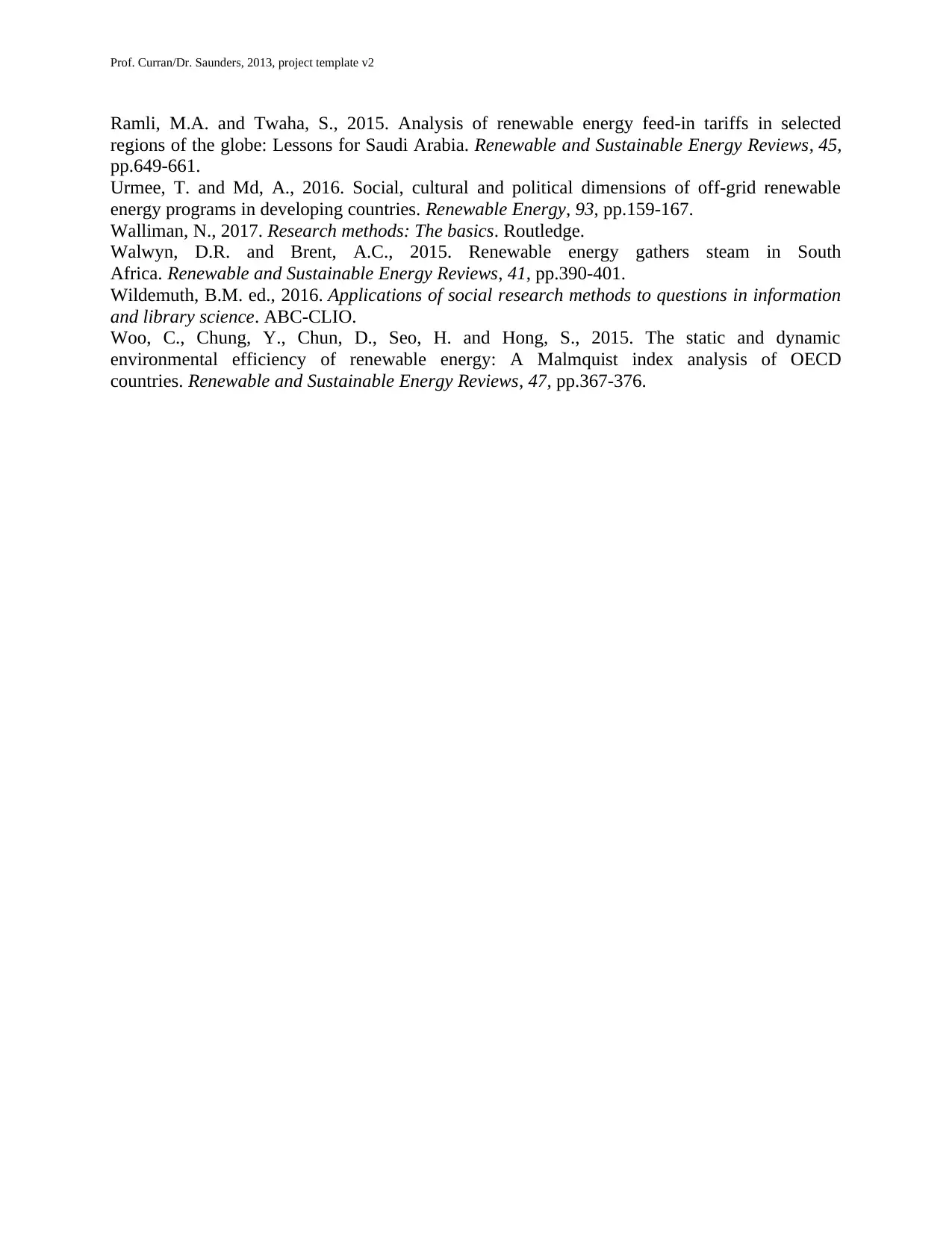
Prof. Curran/Dr. Saunders, 2013, project template v2
Ramli, M.A. and Twaha, S., 2015. Analysis of renewable energy feed-in tariffs in selected
regions of the globe: Lessons for Saudi Arabia. Renewable and Sustainable Energy Reviews, 45,
pp.649-661.
Urmee, T. and Md, A., 2016. Social, cultural and political dimensions of off-grid renewable
energy programs in developing countries. Renewable Energy, 93, pp.159-167.
Walliman, N., 2017. Research methods: The basics. Routledge.
Walwyn, D.R. and Brent, A.C., 2015. Renewable energy gathers steam in South
Africa. Renewable and Sustainable Energy Reviews, 41, pp.390-401.
Wildemuth, B.M. ed., 2016. Applications of social research methods to questions in information
and library science. ABC-CLIO.
Woo, C., Chung, Y., Chun, D., Seo, H. and Hong, S., 2015. The static and dynamic
environmental efficiency of renewable energy: A Malmquist index analysis of OECD
countries. Renewable and Sustainable Energy Reviews, 47, pp.367-376.
Ramli, M.A. and Twaha, S., 2015. Analysis of renewable energy feed-in tariffs in selected
regions of the globe: Lessons for Saudi Arabia. Renewable and Sustainable Energy Reviews, 45,
pp.649-661.
Urmee, T. and Md, A., 2016. Social, cultural and political dimensions of off-grid renewable
energy programs in developing countries. Renewable Energy, 93, pp.159-167.
Walliman, N., 2017. Research methods: The basics. Routledge.
Walwyn, D.R. and Brent, A.C., 2015. Renewable energy gathers steam in South
Africa. Renewable and Sustainable Energy Reviews, 41, pp.390-401.
Wildemuth, B.M. ed., 2016. Applications of social research methods to questions in information
and library science. ABC-CLIO.
Woo, C., Chung, Y., Chun, D., Seo, H. and Hong, S., 2015. The static and dynamic
environmental efficiency of renewable energy: A Malmquist index analysis of OECD
countries. Renewable and Sustainable Energy Reviews, 47, pp.367-376.
1 out of 10
Related Documents
Your All-in-One AI-Powered Toolkit for Academic Success.
+13062052269
info@desklib.com
Available 24*7 on WhatsApp / Email
![[object Object]](/_next/static/media/star-bottom.7253800d.svg)
Unlock your academic potential
Copyright © 2020–2025 A2Z Services. All Rights Reserved. Developed and managed by ZUCOL.





